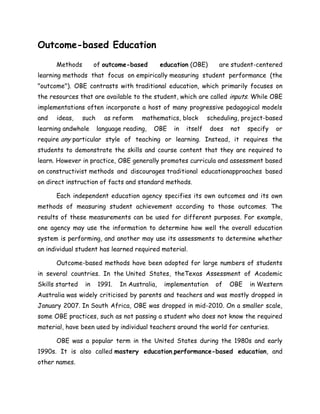This document provides an overview of outcome-based education (OBE). It discusses that OBE is a student-centered approach that focuses on empirically measuring student performance outcomes rather than inputs like resources. While OBE does not specify teaching styles, it generally promotes constructivist methods over direct instruction. Assessment is based on whether students demonstrate required skills and content mastery. Implementation of OBE varies by country and agency, with some adopting it for all students and others facing criticism from parents and teachers.


![In fact, under the traditional model, student performance is expected to
show a wide range of abilities. The failure of some students is accepted as a
natural and unavoidable circumstance. The highest-performing students are given
the highest grades and test scores, and the lowest performing students are given
low grades. (Local laws and traditions determine whether the lowest performing
students were socially promoted or made to repeat the year.) Schools used norm-
referenced tests, such as inexpensive, multiple-choice computer-scored questions
with single correct answers, to quickly rank students on ability. These tests do not
give criterion-based judgments as to whether students have met a single standard
of what every student is expected to know and do: they merely rank the students
in comparison with each other. In this system, grade-level expectations are
defined as the performance of the median student, a level at which half the
students score better and half the students score worse. By this definition, in a
normal population, half of students are expected to perform above grade level and
half the students below grade level, no matter how much or how little the students
have learned.
http://en.wikipedia.org/wiki/Outcome-based_education
WHAT IS THE K TO 12 PROGRAM?
The K to 12 Program covers Kindergarten and 12 years of basic education (six
years of primary education, four years of Junior High School, and two years
of Senior High School [SHS]) to provide sufficient time for mastery of concepts
and skills, develop lifelong learners, and prepare graduates for tertiary education,
middle-level skills development, employment, and entrepreneurship.](https://image.slidesharecdn.com/josaiah-140622064658-phpapp02/85/Dante-Montebon-iloveyouJCD-3-320.jpg)
![SALIENT FEATURES
Every Filipino child now has access to early childhood education through
Universal Kindergarten. At 5 years old, children start schooling and are given the
means to slowly adjust to formal education.
Research shows that children who underwent Kindergarten have better completion
rates than those who did not. Children who complete a standards-based
Kindergarten program are better prepared, for primary education.
Education for children in the early years lays the foundation for lifelong learning
and for the total development of a child. The early years of a human being, from 0
to 6 years, are the most critical period when the brain grows to at least 60-70
percent of adult size..
[Ref: K to 12 Toolkit]
In Kindergarten, students learn the alphabet, numbers, shapes, and colors through
games, songs, and dances, in their Mother Tongue.](https://image.slidesharecdn.com/josaiah-140622064658-phpapp02/85/Dante-Montebon-iloveyouJCD-4-320.jpg)





